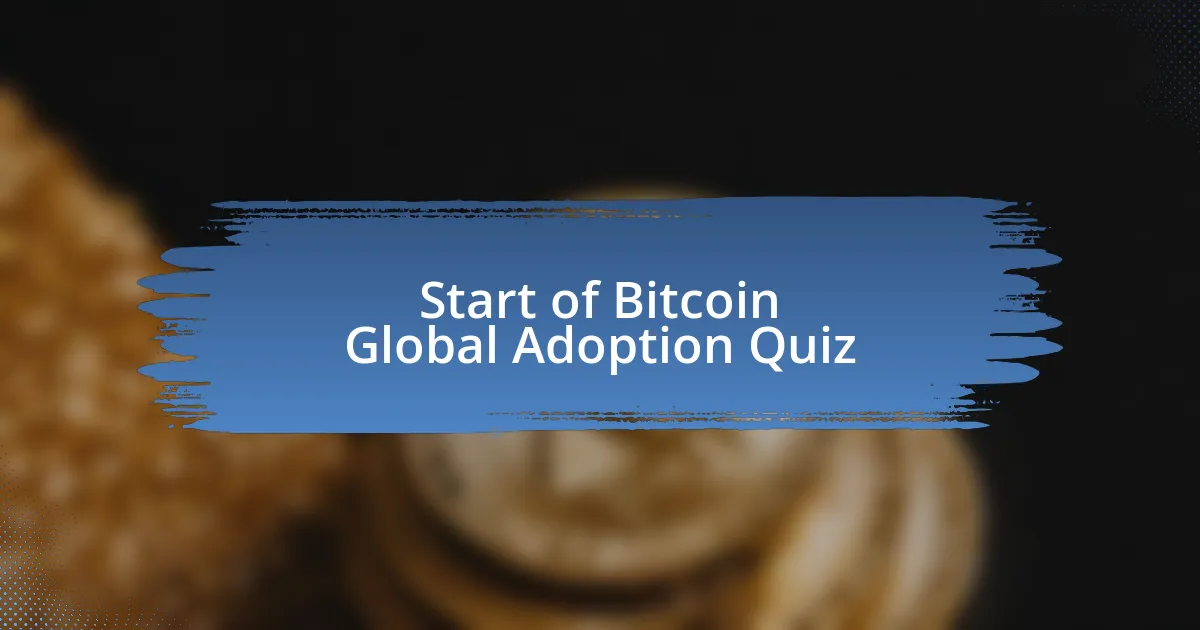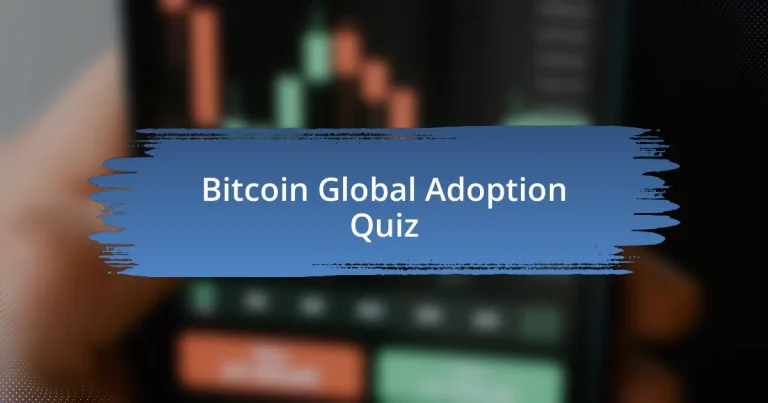
Start of Bitcoin Global Adoption Quiz
1. Who created Bitcoin?
- Roger Ver
- Charlie Lee
- Vitalik Buterin
- Satoshi Nakamoto
2. What is the original document that proposed Bitcoin?
- The Bitcoin Manifesto
- The Bitcoin White Paper
- The Bitcoin Agreement
- The Bitcoin Proposal
3. What is the name of the bitcoin exchange from Japan that famously collapsed in 2014 due to a devastating hack?
- Mt. Gox
- Kraken
- Binance
- Bitstamp
4. How many bitcoin will ever be created?
- 50 million
- 21 million
- 10 million
- 100 million
5. What is the name of the technology underlying Bitcoin?
- Cryptocurrency
- Datastore
- Blockchain
- Ledgertech
6. True or false? Bitcoin can be sent to an Ethereum address.
- False
- Uncertain
- True
- Maybe
7. What date was the Bitcoin network launched?
- December 25, 2007
- January 3, 2009
- March 15, 2008
- February 1, 2010
8. When was Bitcoin’s all-time high exchange rate achieved (as of 9/11/18)?
- December 17, 2017
- November 15, 2017
- July 30, 2018
- January 1, 2018
9. Which of the following statements is true?
- Bitcoin is a type of stock.
- Bitcoin has smart contract capabilities.
- Bitcoin transactions are entirely anonymous.
- Bitcoin can only be mined by companies.
10. How often, on average, can we expect a new block be found by miners?
- 5 minutes
- 15 minutes
- 30 minutes
- 10 minutes
11. What is Bitcoin Pizza Day, May 22nd?
- The day when 10,000 BTC were spent on pizza.
- The day Bitcoin was created.
- The day the first Bitcoin exchange opened.
- The day Bitcoin reached its all-time high.
12. What is SHA 256?
- A network protocol for peer-to-peer communication.
- A secure hashing algorithm used by Bitcoin, originally designed by the NSA.
- A programming language used for smart contracts.
- A type of cryptocurrency wallet for storing coins.
13. What is a nonce?
- A method for encrypting personal data in emails.
- A number used once in the proof-of-work process to verify a transaction.
- A type of digital currency used for online purchases.
- A term for a digital contract made on the blockchain.
14. Bitcoin consumes roughly 1 percent of the world’s energy consumption. What does this mean about its security?
- It indicates that Bitcoin`s security is highly energy-intensive.
- It implies that Bitcoin can function without any energy.
- It suggests Bitcoin is less secure than traditional banks.
- It means Bitcoin is not secure at all.
15. Approximately how many people around the world use/own cryptocurrencies?
- 150 million
- 500 million
- 300+ million
- 1 billion
16. What is the global crypto market cap as of August 1, 2022?
- $1.06 trillion
- $750 billion
- $2 trillion
- $500 billion
17. Approximately how much is traded in cryptocurrency per day?
- $45 billion
- $112 billion
- $75 billion
- $250 billion
18. What percentage of cryptocurrency users are Bitcoin owners?
- 35%
- 80%
- 50%
- 65%
19. If $22 was invested in Bitcoin in 2012, how much would it be today?
- $500
- $1 million
- $22,000
- $200,000
20. What percentage of the total market value do the top 10 cryptocurrencies make up?
- 90%
- 88%
- 75%
- 55%
21. How many different types of cryptocurrency are there?
- Exactly 50
- More than 6,000
- Nearly 1,000
- About 100
22. How often is Bitcoin posted about on social media?
- Every 3 seconds
- Every minute
- Every hour
- Every day
23. What is the global blockchain market expected to reach by 2023?
- $50 billion
- $23.3 billion
- $5.8 trillion
- $10.5 billion
24. Which country has more cryptocurrency holders than any other?
- India
- United States
- China
- Russia
25. What is the market capitalization of Bitcoin as of October 24, 2023?
- $500 billion
- $350 billion
- $658 billion
- $1 trillion
26. How many businesses are already accepting cryptocurrency payments?
- 18,000
- 1,000
- 50,000
- 5,000
27. What was the peak in Bitcoin adoption in 2021?
- 30 million BTC addresses holding at least $5 worth of BTC.
- 50 million BTC addresses holding at least $0.10 worth of BTC.
- 25 million BTC addresses holding at least $2 worth of BTC.
- Over 41 million BTC addresses holding at least $1 worth of BTC.
28. What are the significant events for Bitcoin adoption in 2024?
- The halving event and potential SEC approvals of Bitcoin ETFs.
- Bitcoin price stabilization for six months.
- Major Bitcoin mining hardware recall announced.
- New Bitcoin trading platform launches in Asia.
29. What are the factors driving Bitcoin’s global adoption?
- Banking integration, equal wealth distribution, currency peg to gold, and 24/7 customer support.
- High transaction fees, lack of regulation, slow confirmation times, and limited merchant acceptance.
- Decreased mining rewards, celebrity endorsements, social media trends, and seasonal markets.
- Store of value status, institutional interest, layer 2 scaling solutions, and the anticipation of ETFs.
30. What are the obstacles to widespread Bitcoin adoption?
- Lack of interest, funding issues, and climate change.
- Supply chain disruptions, currency stabilization, and social unrest.
- Global warming, poor internet access, and social media saturation.
- Price volatility, centralized exchange risks, regulatory uncertainty, and tech complexities.

The Quiz on Bitcoin Global Adoption Has Been Successfully Completed!
Congratulations on completing the quiz on Bitcoin Global Adoption! We hope you enjoyed testing your knowledge and learned valuable insights along the way. This quiz covered various aspects of Bitcoin’s reach and influence across different countries, highlighting its growing acceptance and impact on the global economy.
It’s fascinating to see how Bitcoin is reshaping financial transactions and fostering innovation. You may have discovered key statistics, trends, or case studies that illustrate Bitcoin’s acceptance in everyday life. Understanding these elements is crucial for grasping the cryptocurrency landscape and its future potential.
If you’re eager to dive deeper into this subject, we invite you to explore the next section on this page. It contains comprehensive information about Bitcoin Global Adoption, including its history, challenges, and implications. Expanding your knowledge on this topic will enhance your understanding of the evolving world of digital currency, so don’t miss out!

Bitcoin Global Adoption
Understanding Bitcoin Global Adoption
Bitcoin global adoption refers to the increasing acceptance and integration of Bitcoin as a legitimate form of currency worldwide. This phenomenon involves individuals, businesses, and governments recognizing Bitcoin for transactions, investments, and remittances. The rise in adoption is driven by factors like the desire for decentralized finance, inflation protection, and technological advancements. As a result, countries with limited access to traditional banking are often at the forefront of this trend.
Key Factors Driving Bitcoin Global Adoption
Several factors contribute to the global adoption of Bitcoin. These include the increasing access to the internet and smartphones, which facilitate cryptocurrency transactions. Additionally, regulatory advancements in various countries provide clarity, fostering confidence in using Bitcoin. Moreover, economic instability in certain regions amplifies interest in Bitcoin as a hedge against inflation and currency devaluation. Financial inclusivity also plays a role. Bitcoin offers unbanked populations a way to participate in the digital economy.
The Role of Governments and Regulations in Adoption
Government policies and regulatory frameworks significantly influence Bitcoin global adoption. Supportive regulations can encourage businesses to accept Bitcoin, enhancing its legitimacy. In contrast, strict regulations can inhibit growth. Some countries, like El Salvador, have adopted Bitcoin as legal tender, signaling strong governmental support. Conversely, China’s crackdown on cryptocurrencies shows how regulation can negatively impact adoption. Clear regulations enable safer transactions, attracting institutional investors and enhancing confidence in the market.
Impact of Bitcoin on Financial Systems Worldwide
Bitcoin’s integration into financial systems is transformative. It challenges traditional banking models by providing decentralized alternatives. This shift could lower transaction costs and increase financial accessibility. Additionally, Bitcoin’s supply limit creates a deflationary asset appeal. As more people adopt Bitcoin, it may lead to systemic shifts in how money is viewed and utilized, potentially decreasing reliance on central banks. Furthermore, Bitcoin can enhance cross-border transactions, reducing reliance on conventional international money transfers.
Challenges Facing Bitcoin Global Adoption
Despite its growth, Bitcoin adoption faces significant challenges. Volatility remains a primary concern for users and investors, deterring long-term trust. Additionally, technological barriers like user experience and security issues can hinder broad adoption. Environmental concerns regarding Bitcoin mining also raise questions about sustainability. Furthermore, misinformation and lack of understanding about cryptocurrency can create skepticism. Addressing these challenges is essential for Bitcoin to achieve widespread acceptance and usage.
What is Bitcoin Global Adoption?
Bitcoin Global Adoption refers to the widespread acceptance and use of Bitcoin as a form of currency or investment across various countries and economic sectors. This includes individuals, businesses, and governments embracing Bitcoin for transactions, savings, and wealth preservation. As of 2021, estimates indicated that over 100 million people were using Bitcoin worldwide, reflecting its growing presence in the global economy.
How is Bitcoin Global Adoption increasing?
Bitcoin Global Adoption is increasing through the rise of payment platforms that accept Bitcoin, the growth of Bitcoin ATMs, and increased interest from institutional investors. Cities and countries are establishing favorable regulations, while awareness of Bitcoin’s benefits continues to spread. Data from Chainalysis showed that Bitcoin transactions grew by over 600% in 2020, highlighting the pace of adoption.
Where is Bitcoin Global Adoption most prominent?
Bitcoin Global Adoption is most prominent in regions such as North America, Europe, and parts of Asia and Africa. Countries like El Salvador made Bitcoin legal tender in 2021, demonstrating significant adoption in a national context. Additionally, urban centers like San Francisco and Berlin have vibrant cryptocurrency communities fueling local adoption.
When did Bitcoin Global Adoption begin to accelerate?
Bitcoin Global Adoption began to accelerate significantly around 2017, coinciding with the dramatic price increase of Bitcoin, which reached nearly $20,000. This surge attracted media attention and spurred interest among retail and institutional investors. Since then, more merchants have begun accepting Bitcoin, contributing to its adoption growth.
Who drives Bitcoin Global Adoption?
Bitcoin Global Adoption is driven by a mix of individual investors, technology enthusiasts, major corporations, and financial institutions. Influential figures like Elon Musk and companies such as Tesla have endorsed Bitcoin, increasing its credibility. Additionally, grassroots movements and local businesses that accept Bitcoin play crucial roles in promoting its use within communities.


